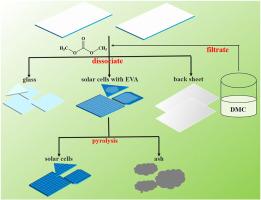从废旧光伏组件中回收有价值的材料作为二次资源:利用环保试剂 DMC 联合热解进行层分离
IF 6.3
2区 材料科学
Q2 ENERGY & FUELS
引用次数: 0
摘要
从废弃光伏组件中回收有价值的材料有利于资源循环利用和环境保护。废弃光伏组件的回收利用是制造过程的逆过程,关键在于分离不同的层。本文首先利用环保试剂 DMC(碳酸二甲酯,C3H6O3)分离废光伏组件的不同层,在固液比为 1:6 g/mL、反应温度为 80 ℃、样品尺寸为 2 × 2 cm 的条件下,获得了清洁的玻璃和背板。机理表明,DMC 主要与醋酸乙烯部分发生反应,将 EVA 分解为乙烯-乙烯醇共聚物,破坏了紧密的交联结构。DMC 保持了原有特性,并经过多次循环。层分离后,在不含氟气体的情况下进行热解,得到了纯太阳能电池和连接带。EVA 链断裂,在空气中氧化分解。整个过程不产生有害物质,为废光伏组件的回收提供了一条可参考的途径。本文章由计算机程序翻译,如有差异,请以英文原文为准。

Recover value materials from waste photovoltaic modules as secondary resource: Layer separation by eco-friendly reagent DMC combined pyrolysis
Recovery of value materials from waste photovoltaic (PV) modules is conducive to resource recycling and environmental protection. Recycling waste PV modules is the reverse process of manufacturing, and the key is to separate different layers. Herein, an eco-friendly reagent, DMC (dimethyl carbonate, C3H6O3), was firstly utilized to separation different layers of waste PV modules, achieving clean glass and back sheet in which the solid-to-liquid ratio was 1:6 g/mL, reaction temperature was 80 °C, and the size of sample was 2 × 2 cm. The mechanism reflected that DMC mainly reacted with the vinyl acetate portion to decompose EVA into ethylene-vinyl alcohol copolymer and destroyed the tight cross-linking structure. DMC retained its original properties and was cycled for several times. Pure solar cells and connecting strips were obtained by pyrolysis without fluorinated gas after layer separation. The chains of EVA broke and was decomposed by oxidation in the air atmosphere. The whole process did not produce hazardous substances and provided a referable route for the recovery of waste PV modules.
求助全文
通过发布文献求助,成功后即可免费获取论文全文。
去求助
来源期刊

Solar Energy Materials and Solar Cells
工程技术-材料科学:综合
CiteScore
12.60
自引率
11.60%
发文量
513
审稿时长
47 days
期刊介绍:
Solar Energy Materials & Solar Cells is intended as a vehicle for the dissemination of research results on materials science and technology related to photovoltaic, photothermal and photoelectrochemical solar energy conversion. Materials science is taken in the broadest possible sense and encompasses physics, chemistry, optics, materials fabrication and analysis for all types of materials.
 求助内容:
求助内容: 应助结果提醒方式:
应助结果提醒方式:


